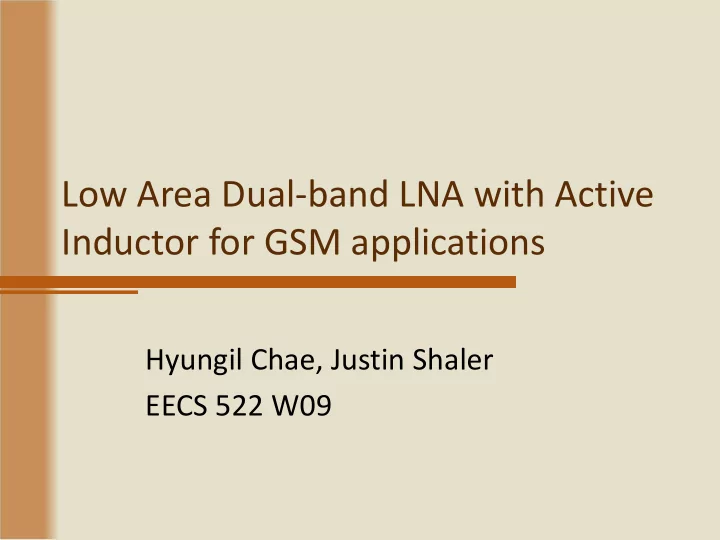

Low Area Dual ‐ band LNA with Active Inductor for GSM applications Hyungil Chae, Justin Shaler EECS 522 W09
Motivation & Application • Different cell phone bands are used over countries – GSM ‐ 850: 880MHz, 25MHz bandwidth – GSM ‐ 1900: 1.96GHz, 60MHz bandwidth – Dual band LNA for device compatibility • Inductors consume large area on analog chip – Bad for yield on wafer, increases unit cost – Try to reduce number of inductors
Design Overview
1.96GHz ‐ Band Schematic VBias Select Active Inductor • Two stage for isolation • Active inductor at load • Select = 1
Band Selection Bias voltage control at Output gating for LNA input isolation
Inductor Options Type Inductance Area Quality Factor Repeatability Noise None 0 Small N/A Good Good On ‐ chip spiral 0.2 to 50nH Large 20 Good Fair External discrete 1 to 150nH Large 150 Fair Fair Bond ‐ wire 0.5 to 5nH Small 150 Poor Fair On ‐ chip active 1 to 200nH Small 0 ‐ 600, tunable Good Poor (Values for f < 2GHz)
Active Inductor Design Active Inductor Equivalent Circuit
Active Inductor Results 20 L (nH) L = 4.59nH at 880MHz 10 0 2 Rs = ‐ 24.06m Ω 0 Rs (ohm) ‐ 2 Compensate by adding external series resistance ‐ 4 ‐ 6 8 Noise (nV/ √ Hz) 6 Noise voltage = 2.67nV/ √ Hz 4 2 Tolerable when active inductor is at LNA output 0 100MHz 200MHz 500MHz 1GHz 2GHz 5GHz
Input Matching (S 11 ) GSM ‐ 850 GSM ‐ 1900 0 SELECT = 0 SELECT = 1 ‐ 10 ‐ 10.7dB S11 (dB) ‐ 11.0dB ‐ 15.0dB ‐ 18.8dB ‐ 20 ‐ 30 500MHz 1GHz 1.5GHz 2GHz
Gain (S 21 ) GSM ‐ 850 GSM ‐ 1900 30 27.5dB 20 SELECT = 0 12.5dB S21 (dB) 10 SELECT = 1 0 ‐ 10 500MHz 1GHz 1.5GHz 2GHz
Noise Figure GSM ‐ 850 GSM ‐ 1900 15 10 NF (dB) 5 SELECT = 0 SELECT = 1 2.92dB 2.88dB 0 500MHz 1GHz 1.5GHz 2GHz
Layout 720um 440um
Results Summary Parameter Select GSM ‐ 850 Select GSM ‐ 1900 Center freq. 906.1 MHz 1888Mhz S11 ‐ 15.0dB ‐ 10.69dB S21 29.86dB 12.74dB NF 2.92dB 2.88dB 3dB ‐ BW 85.2MHz 905MHz P1dB ‐ 0.5dBm 1.995dBm IIP3 ‐ 12.71dBm ‐ 14.0dBm Power 13.27mW 12.97mW 0.301 mm 2 Area
Summary • Switched dual band LNA for GSM 850/1900 bands is presented. • Active inductors can replace passive inductors – Reduce unit cost – Power and noise disadvantage • Still needs passive inductor at input port for high Q and reasonable noise figure
Questions?
References • Active inductor quality factor: Grozing, M.; Pascht, A.; Berroth, M., "A 2.5 V CMOS differential active inductor with tunable L and Q for frequencies up to 5 GHz," Radio Frequency Integrated Circuits (RFIC) Symposium, 2001. Digest of Papers. 2001 IEEE , vol., no., pp.271 ‐ 274, 2001 “3GPP TS 45.005 V8.4.0,” Technical Specification Group GSM/EDGE, Radio Access Network; Radio • transmission and reception. Feb 2009. R. Ramzan, S. Andersson, J. Dabrowski, and C. Svensson, “A 1.4V 25mW inductorless wideband LNA in • 0.13um CMOS,” ISSCC Dig. Tech. Papers , 2007, pp. 424 ‐ 613 D. Shi, N. Behdad, J. Chen, M.P. Flynn, “A 5GHz fully integrated super ‐ regenerative receiver with on ‐ chip • slot antenna in 0.13um CMOS,” VLSI Circuits Symposium , Jun 2008 • Thanachayanont, A.; Payne, A., "VHF CMOS integrated active inductor," Electronics Letters , vol.32, no.11, pp.999 ‐ 1000, 23 May 1996 • Zhuo, W.; de Gyvez, J.P.; Sanchez ‐ Sinencio, E., "Programmable low noise amplifier with active ‐ inductor load," Circuits and Systems, 1998. ISCAS '98. Proceedings of the 1998 IEEE International Symposium on , vol.4, no., pp.365 ‐ 368 vol.4, 31 May ‐ 3 Jun 1998
Recommend
More recommend